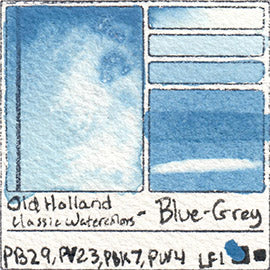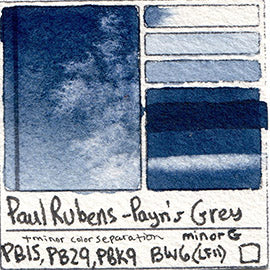BLACK Art Supply Pigment Database Watercolor Acrylic Ink Pencil Color Chart Swatch
Artist reference guide to Black pigments in art supplies. Color chart swatch cards of common pigments in watercolor, gouache, acrylic paint, inks, graphite, charcoal and colored pencils. Each entry includes lightfast ratings from the brand (and any fugitive test result notes from me), index by pigment number code, brand, manufacturer color name, how the color appears in masstone (full strength) or diluted (with water). Each image displays opacity, lifting (erasing with a damp brush), layering (see how dark of a value can be obtained by a 2nd coat of paint) and if it's capable of holding a smooth gradient blend in wet.
PBk1 , PBk6 , PBk7 , PBk8 , PBk9 , Graphite PBk10 , PBk11 , PBk12 , PBk13 , PBk14 , PBk17 , PBk18 , PBk19 , PBk22 , PBk23 , PBk24 , PBk25 , PBk26 , PBk27 , PBk28 , PBk29 , PBk30 , PBk31 , PBk32 , PBk33 , PBk34 , PBk35
Natural, antiquity, mineral or unique black pigments: NBk1, NBk2, NBk3, NBk4 , NBk6 , Acetylene Black , Antimony Black , Black Earth , Black Tourmaline Genuine , Bloodstone Genuine , Cobaltic Oxide , Cuprous Sulfide , Hartshorn Black , Ivory Black Genuine , Lead Sulfide

Also known as Aniline, Azine, Jet or Peach Black. Considered the least lightfast black, with variable fading from LFII to LFIV depending on the brand and form. It has been used as a clothing dye and most often present in student grade gouache paints. This dark value matte black is also mixed in with the more stable PBk7 or PBk9 in some brands to increase its lightfastness. Shinhan Korea and Holbein Japan both offer PBk1 in watercolor form, lightfast test in progress (any updates will be added to the fugitive pigments list page) (C.I. 50440).

PBk1 Mixtures:
Also known as Lamp Black. LFI / BW8. Staining black made synthetically from petroleum residue, or found naturally in Shungite. Many companies have labeled their PBk6 paint as Lamp Black, but that should not be confused with PBk7. (C.I. 77266)



PBk6 Mixtures:












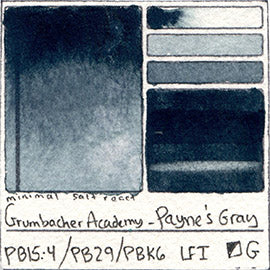



Also known as Carbon Black or Ivory Black. LFI / BW8. Made from the soot residue of petroleum, natural gas, or lamp oil burning. (C.I. 77266)
PBk7 Mixtures:
PBk8 Vine Black: Lightfast. Usually made from plant matter that has been burned in a low oxygen container to make charcoal. PBk8 can also include mineral deposits, such as when a forest fire caused a charcoal sediment layer. Often mildly granulating, sometimes with tiny speckles of burned plant particles that will no longer smooth out in wet washes. This pigment is overall uncommon in watercolor (Roman Szmal, Old Holland), but Schmincke and Nitram also make "liquid charcoal" which works very similarly with a matte gouache-like finish. Powder charcoal is available from more than a few manufacturers (Coates, General Pencil, Jackson's etc) which make willow and grape vine charcoal for drawing. In addition to those pre-made powders, you could DIY Pbk8 by placing dry vines/sticks into an altoids tin or covered pot and placing it into a campfire for several hours. Can be easily ground with a mortar and pestle, then mixed with gum arabic for DIY watercolor. Schmincke's liquid charcoal uses fruit seeds and is one of the most finely ground, deep valued and high quality products of them all. Schmincke's Grape Seed Black is remarkably cool, with hints of blue undertones. I have read that "cork black" was considered "the poor man's ultramarine" historically, because it was the most blue of black pigments made for a time. (C.I. 77268)





PBk8 Mix
tures:
PBk9 Bone Black:
Also known as Ivory Black. LFI / BW8. Made from the burning (calcined/heated) animal bones, resulting in a mixture primarily made up of carbon and calcium. Paints labeled as Ivory Black should mention that it is a hue, since true Ivory Black requires elephant tusks & is banned in most countries. Sadly this pigment is rarely properly named Bone Black and hardly ever referred to as Ivory Black "Hue" (replica), but rest assured no Elephants were harvested for their Ivory to make PBk9. (C.I. 77267)
PBk9 Mixtures:
PBk10 Graphite:
LFI / BW8. Pigment made from the crystallized mineral form of Carbon. There are many natural forms of Graphite, including micaceous flake embedded in layers of other rocks which has a glittering mica appearance. Graphite is often synthetically processed (separating particles via elutriation or flotation and then purified) to allow for up to 99% pure carbon. It ranges from silvery gray to black, often with a luster. Even if the luster/sheen is not visible when painted, it can often be polished/burnished/buffed to a metallic shimmer or sheen (flattening the particles into a reflective surface, like a shoe-shine).

Many graphite products are made using a synthetic resin, starch or gum binder to be used as watersoluble paints. Most dry graphite paints can be buffed to a sheen, but this is reduced when the carbon content is high and the graphite is nearly black. Schmincke Horadam watercolor can not be polished even when rubbing the dried paint very hard with a smooth hard object (paint brush handle, back of a spoon or even a finger nail). This is mostly because Schminke's watercolor is very dark, high carbon, but also very fine particle size and above average amount of gum sealing the pigment. If you're looking for a metallic-like lustrous effect, I recommend another brand - such as ArtGraf. In heavy body acrylic paints, this luster effect can mimic real metal. Sennelier, Golden or Vallejo make wonderful PBk10 heavy body acrylics (with Vallejo being my favorite for most pigment to binder ratio, allowing for easy buffing without being too sealed in the binder). In acrylics raised brush strokes or held surface texture patterns can be allowed to dry, then rubbed to a shine resembling polished dark silver to gunmetal colored metals. (C.I. 77265)

Graphite pencils are sometimes called "lead pencils" but modern pencils are made using graphite mixed with clay and other non-toxic binders - they do not contain toxic lead. The most common school pencils (standard "2b") as well as artist grade pencils (ranging from pale hard formulas to soft and highly pigmented darker ones) as seen in the image above can be rubbed onto sand paper to create a powder. You can use a blending stump (paper tortillon) for smoothly blended painterly effects, or stir it into some gum arabic on a dish to create easy DIY watercolor paint. This is a great way to use up some pencils you may have laying around while testing out if this pigment color is a good fit for your art style.
PBk10 Mixtures:















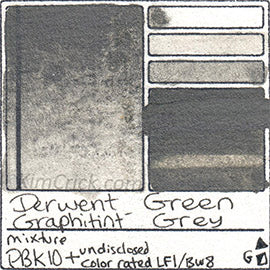

PBk11 Mars Black:
Lightfastness not rated. Black Iron Oxide, formula Fe3O4. Can be made from chemically altering (heating) other Iron Oxides, or found naturally as Magnetite. Some pigment suppliers will provide you with information regarding the source of their Black Iron Oxide. Unfortunately, this pigment code does not benefit from the standard synthetic or natural distinction that has been assigned to other iron oxides. The others have received multiple pigment codes (such as synthetic PY42 vs natural PY43 Yellow Iron Oxide, synthetic PBr6 vs natural PBr7 Brown Iron Oxide or synthetic PR101 vs natural PR102 Red Iron Oxide). Most "natural" PBk11 pigment powders will usually need to be filtered in some way (particles separated from impurities), since rocks containing magnetite often form side by side with other materials such as quartz (SiO2) and hematite (Fe2O3). PBk11 watercolor is offered in many particle sizes, with the finest smallest ones being smoother and the most coarse large particles being extremely granulating. The most textural options I've seen include Lunar Black from Daniel Smith and Aquarius Black from Roman Szmal. (C.I. 77489 / 77499)
PBk11 Mixtures:





















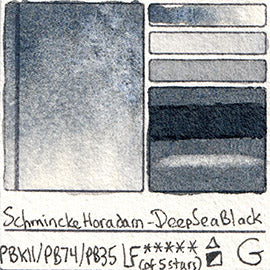






PBk12 Iron Titanium Brown Spinel:
Uncommon. LFI / BW8. Made by heating Iron Oxide & Titanium Oxide, or found in Ilmenite ore with the chemical formula FeTiO3. (C.I. 77543)
Uncommon. LFI. Slightly toxic. Usually produced from various forms of Cobalt Oxide. (C.I. 77322)
AKA Pyrolusite. Uncommon. LFI. Slightly toxic. Can be prepared synthetically from Manganese ores, or found naturally in Pyrolusite or Polianite. (C.I. 77728)

Uncommon. Lightfastness not rated. Chemical formula of ZnS, found naturally in the mineral Sphalerite or made synthetically from mixing Zinc salts with Hydrogen Sulfide. (C.I. 77975)
Uncommon. Lightfastness not rated. Typically an aluminum silicate, but may contain varying amounts of carbon. (C.I. 77011)
AKA French Ardoise Grey. LFI / BW8. Very few paint makers offer this pigment. It is a dull, weak gray that may produce unpleasant texture in watercolor (as seen in Qor). Has been called Davy's Grey Deep by Williamsburg oil paint, which offers two options for PBk19 including a lighter greenish and darker cooler gray version. Most brands of "Davy's Grey" are a pale greenish-gray multi pigment mixture (including a black and white mixed with a green like PG18 or PG23). PBk19 can be made synthetically with Aluminum Silicates, or found naturally as Slate (a sedimentary rock made up of clay or volcanic ash, often a combination of minerals such as quartz, illite and chlorite). (C.I. 77017)

PBk19 Mixtures:
PBk22 Copper Chromite Black:
Uncommon. LFI. Slightly toxic. Made from crystalline Copper Chromite (Cu2Cr2O5). (C.I. 77429)
Uncommon. Lightfastness not rated. Slightly toxic. Made by heating varying mixtures of Tin Oxide & Antimony Oxide, but can contain other materials (C.I. 77865)
PBk24 Titanium Vanadium Antimony Gray:
Uncommon. Lightfastness not rated. Slightly toxic. Product of heating Titanium Oxide, Vanadium Oxide & Antimony Oxide. (C.I. 77898)
PBk25 Cobalt Nickel Gray:
Uncommon. Lightfastness not rated. Slightly toxic. Heating Cobalt Oxide with Nickel Oxide results in a Cobalt Nickel matrix. May contain other trace minerals. (C.I. 77332)
PBk26 Manganese Ferrite Black:
Rare, lightfast deep black that comes from ferrous or ferric iron mixtures with Manganese, and can be diluted to a huge value range of neutral grays. Offered as Spinel Grey by Rembrandt or Neutral Tint by Maimeri Blu, this pigment is new to the watercolor world being present in just two brands as of 2018-2021. I am hopeful it will be added to more brands in the future, as it is one of the most impressively smooth, non-granulating, fine particle, extremely neutral (very little warm or cool bias) black pigments with a useful pitch-black ink-like masstone. The Rembrandt version is slightly easier to lift, salt react and dries more flat (very matte, non-glossy) in comparison to Maimeri Blu's version. (C.I. 77494)
-
-
This pigment does not reflect light, but rather seems to absorb it - giving the appearance of a black hole. It can be remarkably helpful to design work as an alternative to black gouache, but also as a way to darken colors when mixing instead of using a neutral tint mixture. Notably dark in masstone (see bottom right square). The area above the LIFT stripe does have a second layer stripe added after dry, but it does not appear different because this color was capable of being pitch black in a single layer.
PBk27 Iron Cobalt Chromite Black:
Uncommon. Lightfastness not rated. Slightly toxic. Mixture of Iron, Cobalt & Chromium Oxides is heated, ideally to form the compound CoCrFeO4.(C.I. 77502)
PBk28 Copper Chromite Black:
Uncommon. LFI. Slightly toxic. Chemical compound of CuCr2O4,differing very slightly from PBk22. (C.I. 77428)
Uncommon. LFI. Slightly toxic. Typically found in the formula CoFe2, but amounts of Cobalt & Iron Oxides mixed can vary. (C.I. 77498)
PBk30 Chrome Iron Nickel Black:
Uncommon. Lightfastness not rated. Mixed metal oxide consisting of Chromium, Iron & Nickel in the ideal formula of (Ni,Fe)(Cr,Fe)2O4. (C.I. 77504)
PBk31 Perylene Green:
Also known as Shadow Green. Typically rated LFI /BW8, but some minor fading has been reported in tints. Synthetic organic. Very deep green color produced from the Perylene series of hydrocarbons (also used in the creation of Perylene Violet/Red/Maroon and other colors). (C.I. 71132)
PBk32 Perylene Black:
Uncommon, I have only found this pigment used in Roman Szmal's Aquarius watercolors. LFI. Very dark green with slightly warmer, yellow-brown leaning coloration compared to the cooler PBk31 version. Inorganic. Produced from the Perylene hydrocarbon compounds. (C.I. 71133)
PBk33 Iron Manganese Oxide:
Uncommon. LFI. Mixture consisting of Iron Oxide & Manganese Oxide, ideal formula of Fe2MnO. (C.I. 77537)
PBk34 Molybdenum Disulfide:
Uncommon. LFI. Compound of Molybdenum & Sulfur, to create the formula Fe2. Pigment color is usually a silvery black color that can be found naturally in the mineral molybdenite. (C.I. 77770)
PBk35 Titanium Dioxide Black:
Uncommon. LFI. Typically produced by chemical reduction, this compound has also seen use as a photocatalyst & material for energy production. (C.I. 77890)
NBk1, NBk2, NBk3, NBk4 Logwood:
Uncommon. Lightfastness not rated. Logwood Dye mixed with pigments to form a Lake. Also known as Hematoxylin or Hematein. The compound comes from the heartwood of the Logwood tree. (C.I. 75290 / 75291)
Uncommon. Lightfastness not rated. Naturally occurring hydrocarbons that results in compound similar to coal tar-based asphalt.
Uncommon. LFI. A crystalline Carbon Black pigment of high purity made via decomposition of Acetylene (the simple hydrocarbon C2H2 Ethyne).
Uncommon. Lightfastness not rated. Highly Toxic. Usually in the form of powdered Stibnite. The mineral is a natural source for Antimony (Sb), and has the chemical formula Sb2S3.
Uncommon. Lightfastness not rated, but likely to be fugitive (similarly to Brown Earth/Vandyke Brown NBr8) due to the nature of minerals mixed with surrounding organic matter. The stable core composition of this pigment can vary, containing Iron Oxides, Magnetite, Graphite etc. (C.I. 77268)
Black Tourmaline Genuine: A rare mineral pigment offered by Daniel Smith.
Bloodstone Genuine: A rare mineral pigment offered by Daniel Smith. Bloodstone gets its name from the red spots of hematite mixed throughout green jasper. Lightfast, granulating near-black red-brown.
Uncommon. Lightfastness not rated. Co2O3 is rare & reportedly less stable than other oxides of Cobalt. (C.I. 77323)
Uncommon. Lightfastness not rated. Also known as Copper(I) Sulfide, with formula Cu2S - found naturally in Chalcocite. (C.I. 77449)
Uncommon. Lightfastness not rated. Made by heating the horns of male Red Deer, which can be commonly found throughout most of Europe.
Uncommon. Lightfastness not rated. Illegal in most countries, due to the creation involving calcined (burnt) elephant tusks. This dark black pigment has been replaced by the use of cattle and other animal bones (typically obtained as a waste product from the food industry) and charred into making the common "Ivory Black" pigment known as PBk9.
Uncommon. Lightfastness not rated. Chemically, it is Lead Sulfide (PbS), which can be found in nature as the ore Galena.
Swatch card template available for
download here, or get the
rubber stamp here. Swatch cards were painted on Legion Black or Arches Cold Press 100% cotton watercolor paper. Paper and brushes are available at Jackson's or Amazon here:

I purchase most of my art supplies at Blick or Jackson's art materials.

I use affiliate links only to stores that I have personally shopped with. When available I'll include multiple reputable stores so you can compare and decide where you'd like to shop. Dick Blick ("DB" links below) is a large art supply chain store here in the USA that ships worldwide. Jackson's ("Jack" links below) is a great UK based art supply store which also ships worldwide, but carries some harder to find European products with quick low cost shipping to the USA. Amazon USA ("Ama" links below) often offers unique brands, including small business and Chinese off brand watercolor sets, that can not be found anywhere else. As an Amazon associate, I earn from qualifying purchases.
Arches 100% cotton cold press 140# watercolor paper is one of the most durable surfaces for technical pen, scrubbing and lifting. It's surface sizing (coating) and texture is a good middle ground compared to the extremes of different brands. Due to these traits, and it being around for long enough to be the most commonly recommended paper for professionals, all of my swatches are done on this paper for consistency. Only white (and mica paints that do not show up on white) use the Legion Black paper instead. I buy my arches paper at Blick, and if you are in the USA this is likely the most affordable place to buy it: https://shrsl.com/2765w
Alpha by brand shopping directory:
Daniel Smith watercolors -- available on
DB,
Jack or
Ama.
Interested in other ways to help this project? Visit me at
Kimberly Crick Art on YouTube or
Patreon. If you have supplies that you would like to donate, such as watercolor dot cards or samples from your company that you would like reviewed or displayed in this pigment directory, please email me at enchantedgallery@gmail.com or use the
contact form with details. Thank you :)

Note: this page contains affiliate links. All product opinions are my own. I am committed to honest reviews showcasing both the pros and cons of each product. I have not received payment from any brand for a review. I earn a commission from sales made through this web page's clickable banners or links to Amazon, Arteza, Scrapbook, Jackson's or Blick Art Materials websites.




































